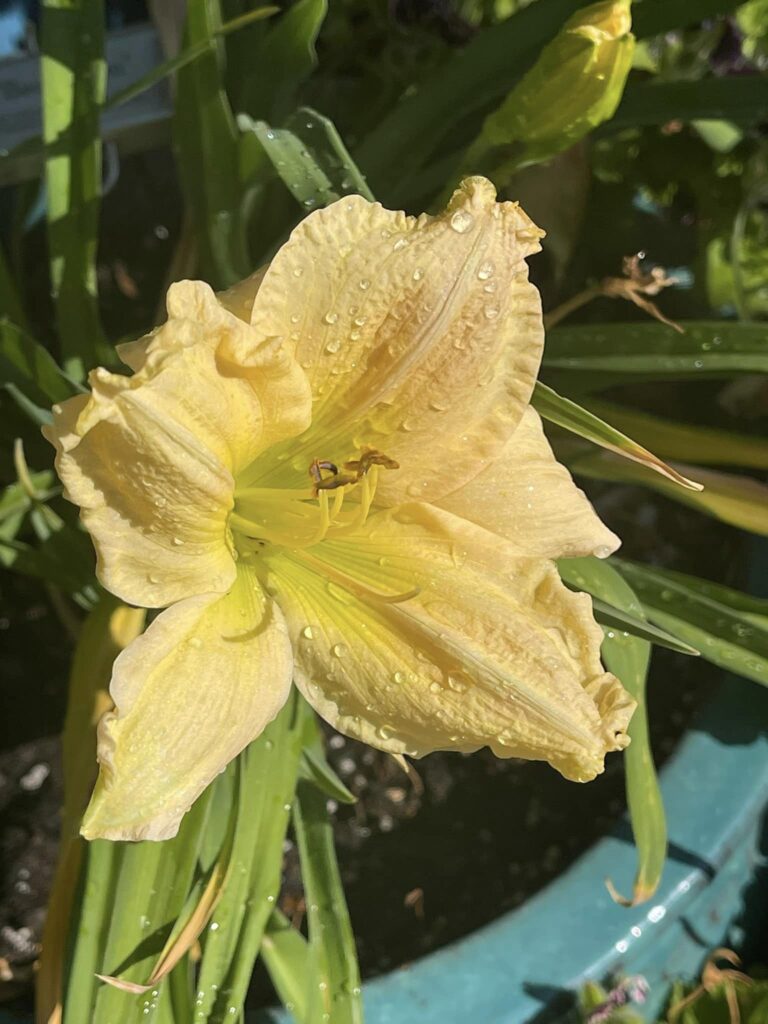Thousands of new daylily crosses are created each year but only a few are considered worthy of being named if they show promise of commercial appeal. In 1980 the breeder Bryant Millikan chose to name an interesting subtle yellow-flowered plant for the composer. A pale salmon-pink color is overlaid on top of the yellow petals, and the flower has a green throat. It is semi-evergreen, blooms midseason for daylilies (normally June), and the leaves stand around 26” tall. This daylily can be grown in full or part sun, but full afternoon sun will wash out the overlay of secondary colors as the day goes on.
I found my plant purely by accident while searching for “Beethoven” on eBay many years ago, and it remains a favorite. Unfortunately, because it is indeed subtle and because there are hundreds of less subtle yellow-plus-salmon daylilies on the market, it does not appear to be in commercial cultivation. I could easily imagine a more dramatic daylily flower for the composer of Fidelio, the Fifth, and the Ninth, but I appreciate the quiet beauties of this one nonetheless. In the summer of 2023 I crossed the ‘Beethoven’ daylily with another yellow daylily that has much greater stamina and reblooming characteristics (but whose name I do not know). Only two of the seeds have sprouted, alas, but perhaps next summer we will see how those two crosses look.
Mr. Millikan was an interesting and generous character, as can be read in a short biography on the old Shields Garden website:
“Bryant Millikan lived here in Indianapolis, Indiana, and he was reared in this area. Bryant was a teacher at Shortridge High School. He was a math teacher, but he could have been an English teacher, as he was a stickler for the proper use of the English language. As a young man, Bryant raised and ‘hybridized’ horses. The best horse he ever raised was named ‘Denmark Adonis’; his second favorite horse was named ‘Sampson.’ Before Bryant grew daylilies, his yard was covered with hundreds of roses. He tells the story of showing up at a rose show a few minutes late and how disappointed (read angry) that they would not let him show his roses. He from that day on he refused to attend or enter flower shows and true to form, we never saw him at the local daylily shows. … Bryant was a ‘character’ and I wish I had the time to repeat many of his stories, opinions and sayings. … Bryant was an endless supplier of named plants and seedlings to a local daylily club. Tens of thousands of dollars have found their way to the local club coffers due to Bryant’s generosity. … There is a large daylily bed on the fabulous garden/grounds at the Indianapolis Museum of Art named the ‘Bryant Millikan Memorial Daylily Garden.’ This bed was planted by a handful of local daylily enthusuiasts (including the two of us) with plants donated by both local daylily growers and large clumps donated by Don[ald] Kercheval [1929-2003, a history teacher]. Bryant shared his home and garden with Don Kercheval. After Bryant’s death, Don introduced the selected seedlings that Bryant had planned to place on the market that year.”
(http://www.shieldsgardens.com/DLPlace/MillikanPoll2000-Marifran-Hiltz.html)


Several other plants have been named after the composer and his opera. The following list is divided between websites with photos and those without. It is not complete. If you know of others, please let me know so I can add them to the list.
‘Beethoven’ Cymbidium (bred by Dr. Thomas Bailey, volunteer, American Beethoven Society; not available commercially yet)https://garden.org/plants/view/801037/Orchid-Cymbidium-Beethoven/
Trumpet Daffodil ‘Beethoven’ (pale yellow and yellow, hybidizer R.A. van der Schoot, registered, flowering before 1913, horrible photo)https://garden.org/plants/view/668003/Trumpet-Daffodil-Narcissus-Beethoven/
Fritellaria imperialis ‘Beethoven’ (Crown Imperial)https://www.gardenia.net/plant/fritillaria-imperialis-beethoven
Greigii Tulip ‘Beethoven’s Memory’ (registered C.J. van Bentum Bluefields, 1998)
https://www.garden-en.com/e/en/02210-tulipa-greigii-beethovens-memory-greigii-tulip/
Bergenia ‘Beethoven’ (hybrized by Eric Smith)
https://www.bethchatto.co.uk/conditions/plants-for-general-conditions/bergenia-beethoven.htm
Rosa ‘Beethoven’
https://coolplants.com/en/plants/rosa-beethoven
Miltoniopsis (Pansy Orchid) ‘Beethoven’ (registered by R. Strauss in 1949 with parents Miltoniopsis Lycaena x Miltoniopsis Mrs. J.B. Crum, the first site does not have a photo; the second site has a photo; the third photo is of a cross using ‘Beethoven’ as a parent)
Please note: I believe the ‘Beethoven’ Miltoniopsis is not longer in commercial propagation.
https://orchidroots.com/detail/ancestrytree/?pid=100034504&role=pub
https://www.pinterest.ca/pin/147000375313653124/
https://www.rightplants4me.co.uk/plant/1792/Miltoniopsis%20’Cindy%20Kane%20x%20Beethoven’
‘Fidelio’ Gladiolus
https://www.finegardening.com/plant/gladiolus-gladiolus-fidelio
Tulip ‘Fidelio’
https://www.rhs.org.uk/plants/52602/tulipa-fidelio-(3)/details
‘Fidelio’ African Violet (miniature, A.E. Adams)
https://stpaulias.com/product/fidelio/
https://violetviol.com/product/fidelio-a-e-adams
Tomato ‘Fidelio’
https://myland.decorexpro.com/en/pomidory/tomat-fidelio.html
Some entries on the National Gardening Association website and other websites have no photos:
Trumpet Daffodil ‘Beethoven’ (white, Sir C.H. Cave, registered, flowering noted 1928, no photo)
https://garden.org/plants/view/503487/Trumpet-Daffodil-Narcissus-Beethoven/
‘Beethoven’ Iris (Barr & Sons, introduced 1887, no photo)
https://garden.org/plants/view/594851/Tall-Bearded-Iris-Iris-Beethoven/
Tropical Hibiscus ‘Moorea Melody Beethoven’ (no information, no photo)
https://garden.org/plants/view/627668/Tropical-Hibiscus-Hibiscus-rosa-sinensis-Moorea-Melody-Beethoven/
‘Fidelio’ Geranium (1981-1982, Ingeborg Schumann, a beautiful salmon-pink color)
https://patents.justia.com/patent/PP5752
If you know of new plants named after Beethoven or his opera or opera characters, please let me know, preferably with a link to a photograph.
